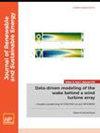Enrichment of fuel properties of biomass using non-oxidative torrefaction for gasification
IF 1.9
4区 工程技术
Q4 ENERGY & FUELS
引用次数: 0
Abstract
The abundance and replenishment nature of solid biomass prompt fuel substitution for gasification and thermal power plants. However, many challenges are encountered while utilizing raw biomass, such as seasonality, strong hydrophilicity, low bulk and energy density, excess oxygen content, less compositional homogeneity, and poor grindability. It is, therefore, indispensable to augment the thermo-chemical properties of the solid biomass by performing suitable pretreatment. Among the various pretreatment techniques, non-oxidative torrefaction effectively upgrades solid biomass to coal-like fuel altering its physico-chemical properties. Therefore, in this work, torrefaction of rice husk and sugarcane bagasse have been performed in a fixed bed reactor by varying temperatures from 210–330 °C and residence time from 30–60 min under a non-oxidative environment. The experimental investigation illustrates a decrease in mass and energy yield of the biomass with a rise in temperature and residence time. Conversely, the higher heating value of rice husk and sugarcane bagasse has improved by 119.4% and 128.9%, respectively. The hydrogen-to-carbon (H/C) and oxygen-to-carbon (O/C) ratio of the torrefied biomass has reduced to enriched fuel variety as indicated by the van Krevelen plot. The decomposition and structural modifications were assessed using Fourier transform infrared spectroscopy, x-ray diffraction, and morphology analysis. Based on the experimental observations, it has been found that torrefaction of rice husk at 290 °C and 30 min and sugarcane bagasse at 270 °C and 30 min would generate enriched syngas using a dual fluidized bed gasification system. Furthermore, water gas shift reactions will be promoted to enhance the percentage of hydrogen in the gas mixture.利用气化过程中的非氧化还原反应丰富生物质燃料特性
固体生物质的丰富性和可再生性促使其成为气化和热电厂的替代燃料。然而,在利用原料生物质时会遇到许多挑战,如季节性、亲水性强、体积密度和能量密度低、含氧量过高、成分不均匀以及研磨性差等。因此,通过适当的预处理来增强固体生物质的热化学特性是必不可少的。在各种预处理技术中,非氧化预处理技术能有效地将固体生物质升级为煤燃料,并改变其物理化学特性。因此,本研究在非氧化环境下,通过改变 210-330 °C 的温度和 30-60 分钟的停留时间,在固定床反应器中对稻壳和甘蔗渣进行了热解。实验结果表明,随着温度和停留时间的增加,生物质的质量和能量产量都有所下降。相反,稻壳和甘蔗渣的较高热值分别提高了 119.4% 和 128.9%。从 van Krevelen 图中可以看出,焙烧生物质的氢碳比(H/C)和氧碳比(O/C)已经降低,成为富燃料品种。傅立叶变换红外光谱、X 射线衍射和形态分析评估了分解和结构改性情况。根据实验观察发现,在双流化床气化系统中,稻壳在 290 °C 和 30 分钟的温度下,甘蔗渣在 270 °C 和 30 分钟的温度下,都能产生富合成气。此外,还将促进水气变换反应,以提高气体混合物中氢的比例。
本文章由计算机程序翻译,如有差异,请以英文原文为准。
求助全文
约1分钟内获得全文
求助全文
来源期刊

Journal of Renewable and Sustainable Energy
ENERGY & FUELS-ENERGY & FUELS
CiteScore
4.30
自引率
12.00%
发文量
122
审稿时长
4.2 months
期刊介绍:
The Journal of Renewable and Sustainable Energy (JRSE) is an interdisciplinary, peer-reviewed journal covering all areas of renewable and sustainable energy relevant to the physical science and engineering communities. The interdisciplinary approach of the publication ensures that the editors draw from researchers worldwide in a diverse range of fields.
Topics covered include:
Renewable energy economics and policy
Renewable energy resource assessment
Solar energy: photovoltaics, solar thermal energy, solar energy for fuels
Wind energy: wind farms, rotors and blades, on- and offshore wind conditions, aerodynamics, fluid dynamics
Bioenergy: biofuels, biomass conversion, artificial photosynthesis
Distributed energy generation: rooftop PV, distributed fuel cells, distributed wind, micro-hydrogen power generation
Power distribution & systems modeling: power electronics and controls, smart grid
Energy efficient buildings: smart windows, PV, wind, power management
Energy conversion: flexoelectric, piezoelectric, thermoelectric, other technologies
Energy storage: batteries, supercapacitors, hydrogen storage, other fuels
Fuel cells: proton exchange membrane cells, solid oxide cells, hybrid fuel cells, other
Marine and hydroelectric energy: dams, tides, waves, other
Transportation: alternative vehicle technologies, plug-in technologies, other
Geothermal energy
 求助内容:
求助内容: 应助结果提醒方式:
应助结果提醒方式:


